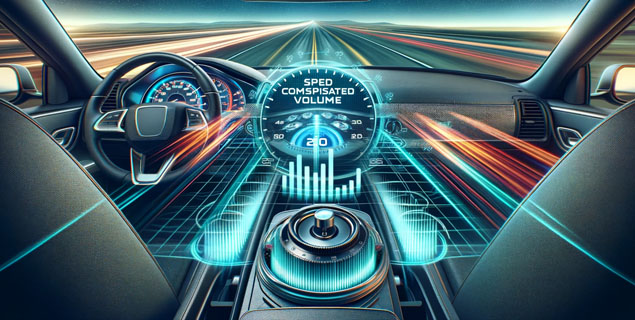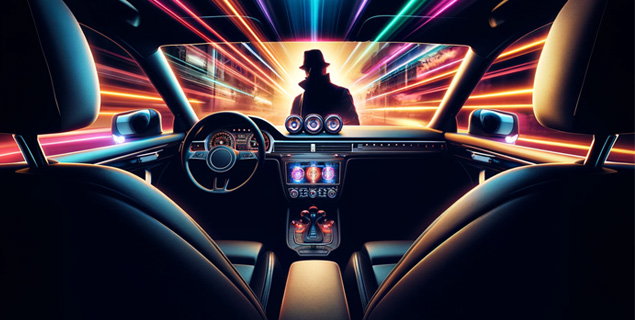Speed Compensated Volume (SCV) is like having a smart DJ in your car who knows just how loud to play your music, no matter how fast you’re going. Imagine cruising down the highway, the wind and road rumbling around you. As your car picks up speed and the world around you gets noisier, SCV turns up the volume just enough so you can still jam out without missing a beat. And when you slow down for a leisurely drive through town, it dials the music back, keeping things chill and not overwhelmingly loud.
This nifty feature is all about keeping your music’s volume perfectly balanced with the noise outside, so you’re not constantly reaching for the volume knob. It’s a small touch that makes your rides more enjoyable, letting you focus on the road while your car handles the soundtrack’s dynamics. Plus, if you’re someone who likes to have things just so, you’ll be happy to know that SCV can usually be tweaked or even turned off, making sure your car’s audio system plays by your rules.
What is Speed Compensated Volume

What does speed compensated volume mean? Speed-compensated volume (SCV) is a feature of some car audio systems that adjust the volume of your music, radio, or other audiables automatically in response to changes in speed. Active Sound aims at a balanced, very smooth acoustic environment in the cabin with the travel speed. Here is a more general look at how Speed Volume Compensation works and what it is made up of.
Functionality:
Noise Compensation:
The Sound of the cabin ambiance level increases relatively with the speed of the vehicle due to wind noise, noise made on the vehicle motion by the type of surface of the road, and noise from the engine. Such sounds may interfere with or intercept the audio being played through the speakers of the car. SCV counters this by increasing the volume of your audio to ensure it remains audible over the background noise.
Volume Adjustment:
The system gradually adjusts the volume of your audio content based on the speed of your vehicle.
Its volume is increasing in the case of acceleration and decreasing in the case of deceleration. All those changes were carried out in an automatic mode, and the development was smooth without a noticeable feeling, preventing abrupt changes that could disturb the driver or passengers.
Technical Aspects:
Speed-sensing:
The SCV systems are either speedometer-linked or digital signals of speed emanating from the vehicle’s computer in order to make a more accurate determination of vehicle speed. It will make the system know when and how much to change.
Customization:
In most cases, the system has the SCV; the driver is allowed to set the volume adjustment level. He is allowed to set how aggressively the volume would be changed as a response to speed change.
In some of the systems, you can adjust the sensitivity to make the changes in volume you are comfortable with.
Manual Override:
For those drivers who prefer not to use the SCV or, and want to control the volume more manually, it is normally possible to turn off the system in the vehicle’s audio installation settings.
Benefits:
Enhanced listening experience:
controlled automatically by the system source volume, SCV maintains a uniform perceived audio level that, in turn, helps improve overall listening. It comes in very handy when going on long drives as the levels of external noise change drastically once you cross through various environments.
Safety:
The fewer manual volume adjustments mean that the drivers can keep their hands on the wheel and their eyes looking down the road for overall better, safer driving conditions.
Comfort:
The quieter acoustical surroundings imply that passengers do not have to raise their voices at each other while the music is playing at any sound level nor reach annoyingly high audio levels at low speeds.
In short, the system of Speed volume compensation is very intelligent in a way that it guarantees the possible best in-car experience by taking suitable action in relation to the volume and the vehicle speed to the output from the speakers so that the Sound of audio output at the speakers is intelligible and constant under all driving circumstances.
Speed Compensated Volume 1-7
SCV system settings generally have options for the driver to change the system to respond to different severity levels according to different vehicle speeds. In numbered situations like this, they would most often represent numbers 1 to 7, for example, and each number would represent various levels of sensitivity or compensation. A more detailed look at what each level may imply, however, is in order. It should be noted that the actual behavior may vary, primarily depending on the vehicle manufacturer and the design of the audio system.
1. Minimum compensation:
The system, therefore, uses subtle volume adjustments at the most basic set point, where the speed of the vehicle is varied. That would be suitable for those who like to keep the volume control very low and for those traveling in quiet conditions, where road noise doesn’t disturb too much.
2. Slight compensation:
this provides slight compensation for speed-related noise in between. That gives some relief for the drivers, who are going to enjoy slight and subtle automatic volume adjustments but want to have the last word with manual control.
3. Moderate Compensation:
This midpoint setting works really well to still down the audio at a higher speed but produces a noticeable fluctuation of sound for the volume so it doesn’t become a distraction. It is ideal for most driving conditions where road noise is present but does not dominate the typical cabin.
4. Balanced Compensation:
In this setting, the compensation is more balanced, with a larger increase in volume noticed as you speed up or slow down; it’s used to provide clear audio under a wider set of conditions when driving.
5. Enhanced Compensation:
At this level, the system aggressively compensates the speed changes of the driver to listen to music or other types of audio content coming from the environment without having the user manually increase the volume to its maximum in environments up to fairly noisy.
6. High Compensation:
Near the top of the scale, designed for the most usual use, i.e., those who often drive under high-background noise conditions on highways and would rather not be in the agony of adjusting the audio system manually.
7. Maximum Compensation:
Most aggressive volume adjustments with changes in speed. It is recommended for a driver who may wish for his audio output to remain relatively constant in very noisy driving environments—high-speed highways or busy urban areas with lots of ambient noise.
Set the SCV level to your typical driving conditions, remembering how much volume you want it to change between in-town driving and highway driving. It can be set once, relying on the most common driving environment, or it can be adjusted on every particular trip.
Conclusion
Speed Compensated Volume (SCV) ensures only that the audio is being kept at optimum levels during drives in a dynamic and instinctive way. By adjusting vehicle volume with the real-time vehicle speed, it provides unbroken listening experience against the noise made from outside the vehicle. This breakthrough technology in acoustic design certainly enhances the comfort and safety of driving. It lets you focus on the road and not to adjust the volume of music time to time. With the speed volume compensation any traveling journey has its favorite music at the perfect volume level. Experience the convenience and sophistication of SCV in your car today for a truly exceptional driving experience.

